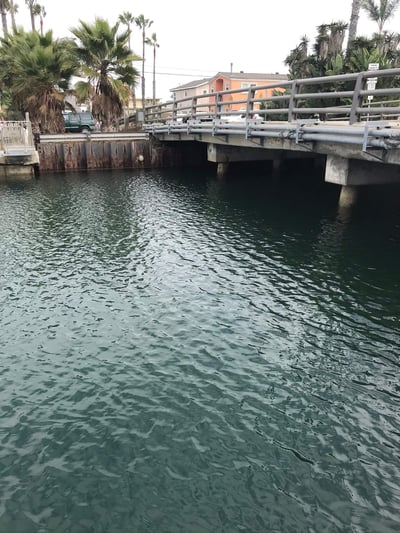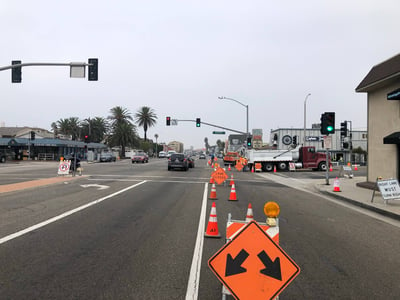Sewer Pipeline
Year: 2021
Author: Murthy Kadiyala


The project is located in the Sunset Beach community within the City of Huntington Beach (City), near Captain Jack’s restaurant at the corner of Pacific Coast Highway and Broadway. The alignment runs along Broadway, approximately 5-feet horizontally north of the existing bridge, from an easterly manhole located near the center of Bayview Drive to a westerly manhole located on the east side of Pacific Coast Highway (PCH).

The Broadway sewer siphon was originally installed under the Sunset Channel in 1935 and was constructed using 6-inch diameter cast iron pipe. The existing cast iron pipe was rehabilitated with a plastic liner in 1987 and although the pipe remains in good working condition, the District is proactively replacing the existing cast iron piping with materials of construction that provides greater resistance to seismic activity. The siphon is within the City’s road right-of-way (ROW) and the bottom of the siphon is approximately 9-feet below mean sea level (MSL).

In preparation for this project, the District conducted an underwater investigation of the Sunset channel in 2019. Based on the results of this investigation, the District speculates that when the Sunset Channel was last dredged, it was not dredged near, nor under the Broadway Bridge, in effect leaving a very shallow channel over the location of the existing sewer siphon. This “mound” extends about 15-feet north of the Broadway Bridge, and some distance south of the bridge. Some debris was found over the siphon, and it is speculated that the siphon was originally installed using a trench and divers. The Broadway Bridge clearance over the channel is low relative to high water elevation and there is only enough clearance for row type boats to go under it, however, not at high tide. The City of Huntington Beach owns the bridge and the steel sheet piling on the channel sides adjacent to and under the bridge.

An objective of this project was to formalize the basis of design for the new sewer siphon utilizing trenchless construction methods. Even trenchless alternatives posed some very unique challenges primarily due to the tight site constraints.

The first step was to compare and evaluate the available trenchless alternatives, such as Horizontal Directional Drilling (HDD), pipe bursting and pipe jacking & boring. Pipe bursting was eliminated from consideration because of the potential to veer off the host pipe alignment due to the curvature of the existing siphon under the channel. Pipe jacking and boring requires large jacking and boring pits adjacent to the channel, which would likely necessitate significant groundwater dewatering. The entry and exit pits for HDD are much smaller and can be located away from the channel. However, unlike this project, HDD is typically employed in open spaces. LEE + RO designed an HDD solution made feasible by identifying underground utilities to be relocated and by aligning the pipe staging area perpendicular to the drill direction. Because the HDD entry and exit pits are located away from the channel and are smaller and shallower than those required for pipe jacking and boring, groundwater dewatering was minimized.
Because the main driver for this project was to provide additional seismic stability for the sewer siphon, high-density polyethylene (HDPE) was recommended for the pipe material. HDPE also provides the pipe bending properties required for both the pipe staging and installation.

Due to the busy and congested nature of the area, design considerations for minimizing the amount of traffic control and disruption to the area were heavily considered. This project is located right next to the Pacific Coast Highway (PCH), which is a busy thoroughfare. Construction impacts and traffic impacts could potentially be significant. A traffic control strategy was implemented for a minimum of one northbound lane of PCH to remain open at all times. PCH northbound No. 2 lane was closed due to the replacement of the sewer manhole. LEE + RO designed the PCH lane closure to double as the pipe staging area. Southbound lanes in PCH were not impacted by this project.
The Broadway bridge is the only land link to Sunset Island. Therefore, Broadway had one lane open in each direction at all times at the intersection with PCH. On the Sunset Island side of the Broadway bridge, at the intersection with Bayview Drive, Bayview Drive closure/detour accommodated the pit excavation, open trenches, and drill rig. All open excavations were backfilled or steel-plated with traffic restored during non-working hours.

The HDD trenchless construction method, aside from cost savings, also benefited the District by avoiding impacts to the channel bottom or sides and discharges of groundwater into the bay water. Avoiding impacts to the channel was anticipated to minimize the permits needed. However, due to the District’s previous experience with governing agencies during their 2019 investigation of the Sunset Channel, applications for permits with Santa Ana Regional Water Quality Control Board, California Coastal Commission, California Department of Fish and Wildlife, U.S. Army Corps of Engineers, and California State Lands Commission were proactively submitted.
The horizontal alignment of the new sewer siphon replacement lies entirely within the City of Huntington Beach public street right-of-way, requiring an encroachment permit from the City. A Caltrans encroachment permit was also acquired mainly to address the traffic impacts to PCH.
LEE + RO was able to determine a solution and prepare the design for the Broadway Sewer Siphon replacement. The solution overcame the hurdle of a confined site, minimized dewatering, minimized the traffic impacts, and minimized the required number of permits.
The District advertised, bid, and awarded the project to Vido Artukovich & Son, Inc./Vidmar, Inc. A Joint Venture, in August 2021. The project successfully completed construction in December 2021, without any design or construction change orders.